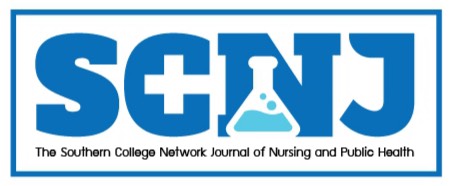ผลการรักษาแบบการแพทย์ทางไกลผ่านการวีดีโอคอลต่อพฤติกรรมการดูแลตนเองและระดับน้ำตาลสะสมในเลือดของผู้ป่วยเบาหวานไทยมุสลิม
คำสำคัญ:
เบาหวาน, การรักษาแบบแพทย์ทางไกล , การรักษาด้วยการพบแพทย์ , พฤติกรรมการดูแลตนเอง , ระดับน้ำตาลสะสมในเลือดบทคัดย่อ
การวิจัยแบบกึ่งทดลองแบบสองกลุ่มวัดผลก่อนและหลังการทดลองนี้เพื่อเปรียบเทียบคะแนนพฤติกรรมการดูแลตนเองและระดับน้ำตาลสะสมในเลือดของผู้ป่วยเบาหวานไทยมุสลิม อ.ยี่งอ จ.นราธิวาส ระหว่างกลุ่มที่รักษาแบบการแพทย์ทางไกล และกลุ่มที่รักษาด้วยการพบแพทย์ กลุ่มตัวอย่างที่ใช้ ได้แก่ ผู้ป่วยโรคเบาหวานที่มารับบริการในในโรงพยาบาลส่งเสริมสุขภาพตำบล จำนวน 102 คน เครื่องมือที่ใช้ในการทดลอง คือ การรักษาแบบการแพทย์ทางไกล และการรักษาด้วยการพบแพทย์ แบบสอบถามพฤติกรรมการดูแลตนเอง แบบบันทึกระดับน้ำตาลสะสมในเลือด ได้ค่าเที่ยงตรงตามเนื้อหาเท่ากับ .91 และค่าความเชื่อมั่นสัมประสิทธิ์แอลฟ่าของครอนบาคเท่ากับ .778 วิเคราะห์โดยใช้ความถี่ ร้อยละ ค่าเฉลี่ย ส่วนเบี่ยงเบนมาตรฐาน สถิติ Chi-square สถิติ Fisher’s Exact Test สถิติ Mann-whitney U Test สถิติ Independent T Test สถิติ Dependent T Test และ สถิติ Wilcoxon Signed Rank Test ผลการวิจัยพบว่า
1. กลุ่มที่รักษาด้วยการพบแพทย์ พบว่าหลังการทดลองคะแนนพฤติกรรมการดูแลตนเองภาพรวม เพิ่มขึ้นและระดับน้ำตาลสะสมในเลือดลดลง อย่างมีนัยสำคัญทางสถิติที่ระดับ .05, .01 และ .001 ส่วนพฤติกรรมด้านการจัดการความเครียด มีคะแนนก่อนและหลังการทดลองไม่แตกต่างกัน สำหรับกลุ่มที่รักษาแบบการแพทย์ทางไกล พบว่าหลังการทดลองคะแนนพฤติกรรมการดูแลตนเองภาพรวม เพิ่มขึ้นและระดับน้ำตาลสะสมในเลือดลดลงอย่างมีนัยสำคัญทางสถิติที่ระดับ .05, .01 และ .001 ส่วนด้านการรับประทานอาหาร ด้านการจัดการความเครียด และด้านการดูแลรักษาต่อเนื่อง พบว่าก่อนและหลังการทดลองไม่แตกต่างกัน
2. หลังการทดลอง พบว่ากลุ่มที่รักษาด้วยการพบแพทย์ ทั้งคะแนนพฤติกรรมการดูแลตนเองภาพรวมและรายด้านมากกว่ากลุ่มที่รักษาแบบการแพทย์ทางไกล เช่นเดียวกับระดับน้ำตาลในเลือดของกลุ่มที่รักษาด้วยการพบแพทย์น้อยกว่ากลุ่มที่รักษาแบบการแพทย์ทางไกล อย่างมีนัยสำคัญทางสถิติที่ระดับ .05, .01 และ .001
ดังนั้นควรนำรูปแบบการรักษาทั้ง 2 วิธีไปใช้ในการรักษาผู้ป่วยควบคู่กันไปเพื่อให้สอดคล้องกับบริบทไทยมุสลิมในจังหวัดนราธิวาสและจังหวัดชายแดนภาคใต้ เพื่อให้ผู้ป่วยได้พบแพทย์อย่างใกล้ชิด เกิดความมั่นใจต่อการรักษา ลดการเดินทาง และลดการแออัดในโรงพยาบาล
References
Chirawatkul, A. (2013). Designing Questionnaires for Research. Bangkok: Witthayapat. (in Thai)
Dawson, K. G., Jin, A., Summerskill, M., & Swann, D. (2021). Mobile diabetes telemedicine clinics for aboriginal first nation people with reported diabetes in British olumbia. Canadian Journal Diabetes, 45(1), 89-95. doi: 10.1016/j.jcjd.2020.05.018.
Department of Medical Services. (2021). Guidelines for Using DMS Telemedicine, Department of Medical Services. Nonthaburi: Ministry of Public Health. (in Thai)
Diabetes Association of Thailand. (2023). Clinical Practice Guidelines for Diabetes 2023. Bangkok: Srimuang Pringing. (in Thai)
Faul, F., Erdfelder, E., Lang, A. G., & Buchner, A. (2007). G*Power 3: A flexible statistical power analysis program for the social, behavioral, and biomedical sciences. Behavior Research Methods, 39(2), 175-191.
Hair, F. J., Black, C. W., Babin, J. B., & Anderson, E. R. (2019). Multivariate Data Analysis. (7th ed). New Jersey: Pearson Education.
Intarachote, U. (2020). The results of supporting participatory self-management in diabetic patients, Na Fai subdistrict, Muang district, Chaiyaphum province. Chaiyaphum Medical Journal, 40(1), 137-147. (in Thai)
Internation Diabetes Federal [IDF]. (2021). IDF Diabetes Atlas. Retrieved June 28, 2024 from https://www.diabetesatlas.org/
Jin, M. X., Kim, S., Miller, L. J., Behari, G., & Correa, R. (2020). Telemedicine: Current impact on the future. Cureus,12(8), e9891. doi:10.7759/cureus.9891
Kang, J. Y., Jung, W., Kim, H. J., An, J. H., Yoon, H., Kim, T., et al. (2024). Temporary telemedicine policy and chronic disease management in south korea: Retrospective analysis using national claims data. JMIR Public Health Surveillance, 10, e59138. doi: 10.2196/59138.
Kisling, L. A., & Das, J. M. (2024). Prevention Strategies. Retrieved June 30, 2024 from https://www.ncbi.nlm.nih.gov/books/NBK537222/
Lohsoonthorn, V. (2018). Epidemiology. Bangkok: Chulalongkorn University Press. (in Thai)
Ming, W. K., Mackillop, L. H., Farmer, A., Loerup, L., Bartlett, K., Levy, J. C., et al. (2016). Telemedicine technologies for diabetes in pregnancy: A systematic review and meta-analysis. Journal of Medical Internet Research, 18(11), e290. doi: 10.2196/jmir.6556.
Pragosuntung, N. (2024). The effect of telenursing program with glycemic control in type 2 diabetes mellitus patients authors. Journal of Research and Health Innovative Development, 5(2), 100-111. (in Thai)
Siangdang, S. (2019). Foot care behaviors with type 2 diabetes at diabetes clinic of Singhanakorn hospital, Songkhla. Thai Journal of Public Health and Health Sciences, 2(3), 1–15. (in Thai)
Somton, T. (2024). Comparative effect of telemedicine on glycemic control management among diabetes mellitus type II patients in Suratthani’s prison healthcare unit. Region 11 Medical Journal, 38(2), 1-10. (in Thai)
Sudnongbua, R. (2024). A comparison efficacy of telemedicine platform and traditional algorithm in patient with diabetes mellitus for control blood sugar in Mahachanachai hospital Yasotorn hospital. Academic Journal of Community Public Health, 10(2), 200-210.
Sun, C., Sun, L., Xi, S., Zhang, H., Wang, H., Feng, Y., et al. (2019). Mobile phone-based telemedicine practice in older chinese patients with type 2 diabetes mellitus: Randomized controlled trial. JMIR mHealth and uHealth, 7(1), e10664. doi.org/10.2196/10664
Tuomilehto, J., Lindstrom, J., Eriksson, J. G., Valle, T. T., Hamalainen, H., Ilanne-Parikka, P, et al. (2001). Prevention of type 2 diabetes mellitus by changes in lifestyle among subjects with impaired glucose tolerance. N Engl J Med, 344(18),1343-1350.
Wongsuphee, P., Chusak, T., & Banchonhattakit, P. (2024). Effects of telemedicine on self-care behaviors and blood sugar level of diabetic patients with uncontrolled blood glucose levels in Huai Khot hospital, Uthai Thani province. Singburi Hospital Journal, 33(2), B49-B61. (in Thai)
Yingo Hospital. (2024). HDC Program. Narathiwat: Yingo Hospital. (in Thai)
Zamani-Alavijeh, F., Araban, M., Koohestani, H. R., & Karimy, M. (2018). The effectiveness of stress management training on blood glucose control in patients with type 2 diabetes. Diabetology & Metabolic Syndrome, 10, 39. doi.org/10.1186/s13098-018-0342-5.

Downloads
เผยแพร่แล้ว
ฉบับ
บท
License
Copyright (c) 2025 วารสารเครือข่ายวิทยาลัยพยาบาลและการสาธารณสุขภาคใต้

This work is licensed under a Creative Commons Attribution-NonCommercial-NoDerivatives 4.0 International License.
1. บทความหรือข้อคิดเห็นใด ๆ ที่ปรากฏในวารสารเครือข่าย วิทยาลัยพยาบาลและการสาธารณสุขภาคใต้ ที่เป็นวรรณกรรมของผู้เขียน บรรณาธิการหรือเครือข่ายวิทยาลัยพยาบาลและวิทยาลัยการสาธารณสุขภาคใต้ ไม่จำเป็นต้องเห็นด้วย
2. บทความที่ได้รับการตีพิมพ์ถือเป็นลิขสิทธิ์ของ วารสารเครือข่ายวิทยาลัยพยาบาลและการสาธารณสุขภาคใต้






